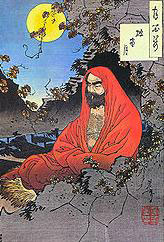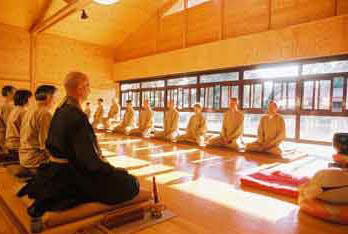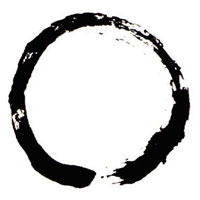Zen Buddhism Zen is a school of Mahayana Buddhism which originated in China during the 6th century BC as Chán. From China, Zen spread south to Vietnam, to Korea and east to Japan. The word Zen is from the Japanese pronunciation of the Middle Chinese word Dzyen, which in turn is derived from the Sanskrit word dhyana, which can be approximately translated as "absorption" or "meditative state". Zen believes that nothing can be taught. In the attainment of enlightenment Zen emphasizes experience or experiential wisdom over theoretical knowledge. Direct realization is through meditation and dharma practice. In “Buddhism as Dialogue” Dr. Alan Watts offers an interesting insight, “Zen plays a little game with you: ‘Those who know do not say, those who say do not know’. And yet Lau Tzu said that!... Poetry is the great language, because poetry is the art of saying of what can't be said -- trying to describe the indescribable.” Chinese Chán The traditional origin of Chán in China is credited to the Buddhist monk Bodhidharma who lived during the 5th/6th century BC. Scarce historical information is available during the time when Bodhidharma taught a "special transmission outside scriptures" which "did not stand upon words". Subsequent accounts of the "The Blue-Eyed Barbarian" are most likely legend. The actual origins of Chán may lie in ascetic practitioners of Buddhism, who found refuge in forests and mountains. Japanese Zen
Zen is the Japanese variant of Chán, a school of Mahayana Buddhism which strongly emphasizes dhyana or concentration-meditation. The goal of dhyana is liberation, the result of Zen meditation that gives insight and awareness to one's true nature and the emptiness of inherent existence. As an example of awareness training, the Zen master (metaphorically) asks the student, "Do you grow your hair?", "Did you color your eyes?" "Do you beat your heart?" "Are you the one that shapes your bones?" The master is teaching Anatman – non-self. That the ego is a social institution, it has no physical reality. The idea of the Anatman is that the ego is unreal, there isn’t one. Your ego has nothing to do with the color of your eyes or circulating your blood. The ego is your symbol of your self. Zen Buddhism is a method of changing consciousness, of changing one's personal identity - of what and who you are (false-ego) – of challenging the student's attachment to dualistic concepts (eg, light and dark, spirit and matter). There is a humorous story told among Zen masters about a student that was getting desperate about producing an answer of who he really is. On his way to an interview with the Zen master, the student saw a bullfrog sitting around in the garden. He grabbed the bullfrog and hid it in the sleeve of his kimono. To give the answer of who he was he showed the master the bullfrog. The master shook his head and replied, “too intellectual, you've been reading too many books". In other words, the master is saying the student's answer is too contrived, too much like Zen!
Meditation is sometimes supplemented by kōan training, especially in Rinzai Zen. One type of a Zen kōan is a riddle or insolvable problem, designed to 'wake up' the student from the illusion of his identity or to student's attachment to dualistic concepts. Buddha means one who has "woken up". The first step in awakening is known as 'satori'. P.S. Wasu, who conducts workshops based on Zen, likens satori to an empty circle: "There comes a state when the Zen practitioner is able to view everything as a synthesis of opposites that arise from one another. All rational judgments become irrelevant and one starts viewing reality intuitively as it actually is—nothingness that is complete in itself, much like an empty circle." Providing an insight into the working mechanism of the koan, Wasu says: "Years of social and psychological conditioning forges certain neural pathways within the brain. Our thinking settles in these grooves making it difficult for us to comprehend satori." “Thinking out of the box” is another way to view the nature of the Koan. The point of the koan is to force our minds to break out of the trap of linear logic. Answers to a kōan vary by circumstance and even by the demands of the teacher. A common response by a teacher on a student's answers is: "Even though that is true, if you do not know it yourself, it does you no good." The master wants to know if the student has grasped the state of the mind expressed by the kōan itself. There's a Zen saying, "What you resist persists, and what you allow to be disappears." Some kōans take the form of question, like the one that asks, "If a tree falls in the forest and no one is around to hear, does it make a sound?" There is no "right" answer to this question. It can be argued for years from either perspective, yes or no. Not all kōans come from Japan. One example is the famous psychological test: "Is the glass half full or half empty?" This is a test to see if one is optimistic (half full) or pessimistic (half empty). A playful alternative reply is to say that the glass is too large for the amount of water presently contained. So, the glass is neither half full nor half empty! There are many other correct ‘answers’ which make kōans useful mind exercises. One major point raised today is that the state of Zen is like that of a dog, always in the moment, regretting nothing.
z
|


